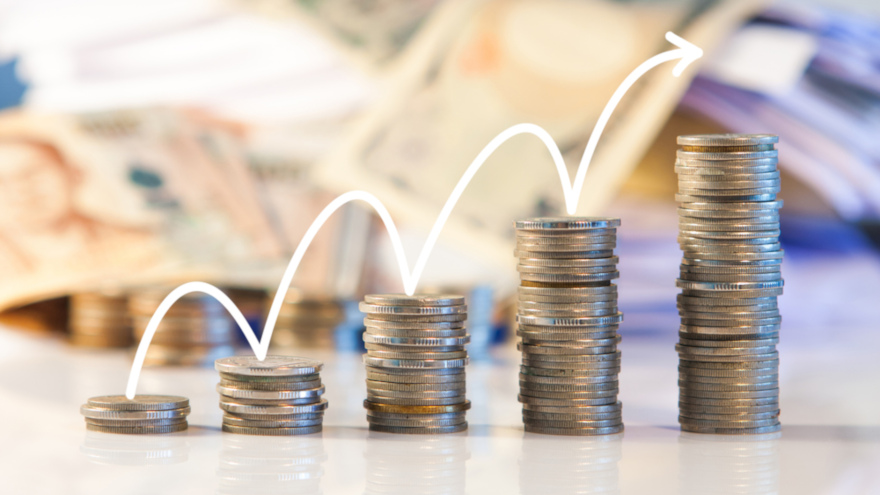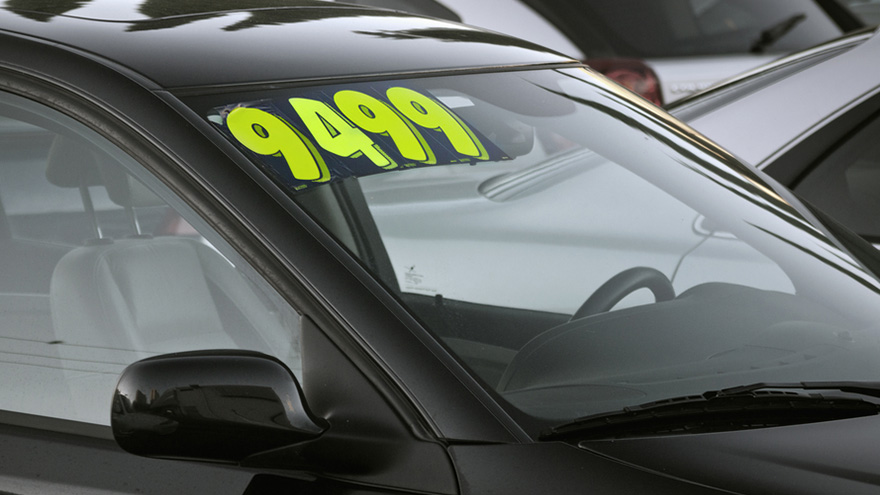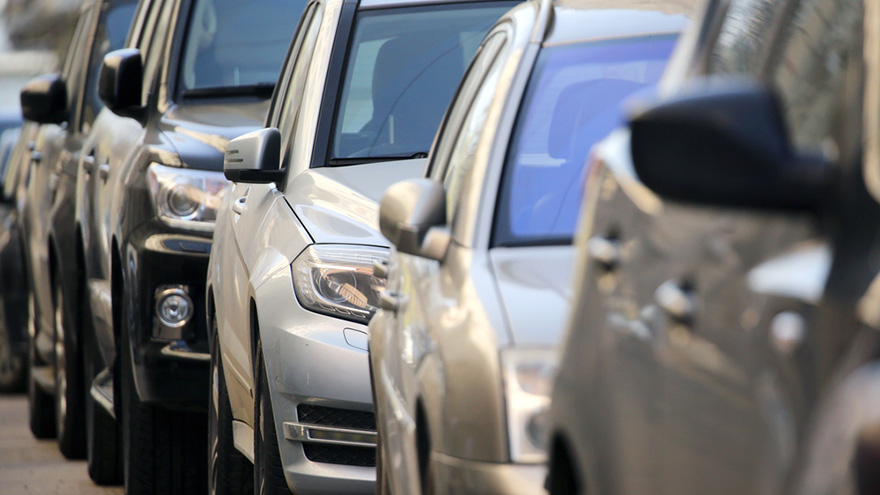A majority of car shoppers are optimistic about the health of the economy. The economic experts, not so much.
Signs are indicating that the next recession is looming right around the corner, but 65 percent of respondents said they expected that their household would be better off financially in a year than it was currently, a recent survey by Autolist.com has found.
Sixteen percent said they expected to be worse off, and 19 percent were unsure.
This optimism was echoed by consumers’ relatively positive outlook on a possible recession.
And about that recession that many experts say is just around the corner? Consumers disagree there, as well.
Just one-third of respondents said they believed the U.S. economy would enter a recession in the next 18 months, Autolist found. Thirty-eight percent said they did not expect to enter a recession, and 29 percent were unsure.
Autolist also pointed to findings in a Duke University survey released in early December, where 49 percent of chief financial officers expected a recession in the next 12 months, while 82 percent of them said a recession was due by the end of 2020.
The auto industry, of course, hope consumers are right on this one. New-vehicle sales are expected to dip only slightly in 2019 compared to 2018. Autolist cited WardsAuto and the National Automobile Dealers Association data predicting 16.8 million new-vehicle sales in 2019, a slight decline compared to the 17.3 million vehicles sold in 2018.
These predictions were mirrored in Autolist’s survey. Sixty-four percent of consumers said now was a good time to buy a vehicle; just 12 percent said it was not and 24 percent were unsure.
The optimistic outlook of consumers was also apparent when Autolist asked car shoppers how or if they would change their next vehicle purchase, should the U.S. economy hit a recession. Thirty-two percent of consumers said it wouldn’t affect what vehicle they chose at all.
The most common behavior change was a switch from shopping for new vehicles to shopping used vehicles; then a move to a less-expensive brand and then a switch from leasing to buying.
Autolist surveyed 2,280 current car shoppers in late December 2018 and early January 2019 for the results.
Data from the Hearst families of companies — including Jumpstart Automotive and Black Book — showed how consumers continue to shift their interest toward used vehicles as new models become more expensive.
However, Cox Automotive’s collection of experts reiterated that automakers certainly are not decelerating their efforts to keep new metal turning, using incentives and other tools at their disposal.
All the developments arrive as Kelley Blue Book determined the average transaction price for new-vehicle retail sales in November came in at $37,654, representing a 4-percent lift year-over-year. And the third-quarter data from Experian showed monthly payments for new and used vehicles again reached record highs — $530 and $381, respectively — and the gap between new and used monthly payments continues to widen, reaching $149.
Perhaps if consumers cannot afford more than $500 per month for that new model, Jumpstart is seeing rises in online activity of shoppers shifting to used.
Analysts indicated 33.6 percent of all visitors to Jumpstart partner websites in October researched used makes and models versus 66.4 percent for new. These metrics compare to October 2017 research-activity figures that showed 30.1 percent for used and 69.9 percent for new.
Jumpstart pointed out the month the most robust used-vehicle research activity came in was May when 35.2 percent of visitors to its partner sites were looking at used vehicles.
“As prices of new vehicles creep up and incentives continue to shrink, it’s expected that consumers will increasingly research and consider used vehicle choices — especially in the 1- to 3-year-old age range — which today have quality and features that compete heavily with new models,” said Colin Thomas, senior analyst for strategic insights and analytics at Jumpstart.
That used-vehicle interest is keeping depreciation in check.
According to Black Book data, average used-vehicle depreciation during the past 12 months stands at 12.5 percent. That’s down from 13.2 percent at this juncture in 2017 and 16.8 percent at this time during 2016.
“There are many choices of gently used vehicles with exceptional value, especially in the sedan categories, as a result of the rising off-lease volume over the last few years,” said Anil Goyal, executive vice president of operations for Black Book.
Which segments of used vehicles are experiencing the most demand currently? The segments with the highest month-over-month gains in the Black Book Retention Index for November included:
— Midsize luxury crossover/SUV: up 0.8 percent
— Sub-compact car: up 0.6 percent
— Midsize car: up 0.5 percent
— Premium sporty car: up 0.5 percent
— Luxury car: up 0.4 percent
OEM effort to push new models intensifies
Of course, automakers certainly do not want their new vehicles aging too much in franchised dealer inventory. And it appears OEMs moved toward slapping higher amounts of cash on the hood to get a lease or retail installment sales contract finalized. Brad Korner, general manager for Cox Automotive Rates and Incentives, elaborated on what unfolded in November.
“The industry was showing restraint and discipline with incentives through the summer and early fall, but that changed in November. Inventories have been inching upwards, particularly on trucks and SUVs, so many makers got aggressive last month with Black Friday deals, special APR incentives and conquest money,” Korner said.
“Many manufacturers are aggressively pursuing ‘Employee Pricing For All’ deals in select markets,” he continued. “We’re also moving into auto show season when many automakers offer special incentives as shows open in cities across the country. All this adds up to better deals in the market. As 2018 winds down, automaker motivation to sell is spinning up.
Autotrader executive analyst Michelle Krebs echoed many of the points Korner noted.
“The incentives ran the gamut of zero percent for 36 to 72 months, cash help for subprime consumers, cash for owners of competitive models and employee pricing for victims of wildfires and hurricanes,” Krebs said. “The incentives cut across all model lines, though specific trim levels and equipment packages, applied in many cases, and they were strategic in geographic targeting.”
With new-model performance perhaps being eroded somewhat by used-vehicle sales, ALG projected U.S. revenue from new-vehicle sales would reach $47 billion for November, down 0.6 percent from a year ago. ALG expects a loss of $284 million in revenue for automakers versus 2017.
“Consumers continue to pay near record amounts for new vehicles, despite the headwinds of stock market volatility and rising interest rates,” said Eric Lyman, ALG’s chief industry analyst. “2018 was expected to be a year of transition with regards to sales, (actual transaction prices) and incentive spending, instead we’ve seen automakers making all the right moves to sustain transaction prices and decrease incentives while maintaining a robust 17 million annual sales rate.”
Edmunds is calling for 3 million used-car sales this month, and while that would be lower than what the market reached in October, the company is calculating that the seasonally adjusted annualized rate for November will actually be higher.
Specifically, Edmunds is projecting a 39.8 million used-car SAAR for November, compared to 39.6 million last month.
This is despite monthly sales dipping from 3.3 million in October to the 3.0 million forecasted for this month.
Meanwhile, in an Industry Update released earlier this month, Cox Automotive said there was an estimated year-over-year increase of 0.3 percent in used-car sales last month, with the annualized pace of used-vehicle sales staying 1 percent ahead of year-ago results.
Cox estimated a 38.1 million-unit seasonally adjusted annualized rate for used-car sales in October, which it said was down just a bit from October 2017.
On the new-car side, Edmunds is projecting 1.38 million retail sales and a 17.3 million SAAR this month.
A year ago, there were 1.39 million new-car sales, meaning this would be the first time in nine years that November new-car sales have declined on a year-over-year basis, according to Edmunds.
During this near-decade time frame, there has been growth in November sales “in part due to increasing demand following the recession, and in part due to November becoming a bigger sales month thanks to automakers and dealers capitalizing on Black Friday,” Edmunds said in a news release.
Sales are expected to be up from October, when 1.36 million new cars were sold.
“Retailers have been pushing Black Friday car deals through the entire month of November, so unless they decide to pull out all the stops in the 11th hour, this is likely going to be the first time we see November sales take a dip in nearly a decade,” said Jeremy Acevedo, Edmunds’ manager of industry analysis, in a news release.
“Although sales remain at a healthy level, factors such as increasing market saturation, rising transaction prices and elevated interest rates continue to create headwinds for the industry overall. November’s sales slowdown signifies a new normal that we can expect through at least the end of 2018, and likely into 2019.”
Used-vehicle sales this past month were strong — as were prices, perhaps easing tight margins in the dealership a bit. These stats and more painted a rosy picture for the used industry, even while many are waiting for the shoe to drop in terms of consequences from rising interest rates and an expected wave of off-lease supply. That’s according to the "July 218 Used Car and Light Truck Guidelines Industry Update" from J.D. Power Valuation Services.
"In terms of full-year expectations, with exceptionally strong performances observed over the past few months, our forecast is improvement for the second month in a row," said David Paris, executive analyst at J.D. Power Valuation Services. "We expect used prices to increase, especially as negative forecast factors hurting used vehicles such as increase in used supply, worsening credit conditions and increase gasoline prices continue to be incentives."
And according to a July prediction from Edmunds.com, an estimated 3.4 million used vehicles will be sold in July 2018, for a SAAR of 39.5 million; this is compared to 3.2 million ― or a SAAR of 39.2 million ― in June.
Highlighting June numbers in more detail, according to the J.D. Power report, seasonally adjusted used-vehicle prices rose by 1.2 percent when compared to May to reach 118.2. As a result, the J.D. Power index rose 4.1 percent year-over-year last month. Interestingly, the report also noted that wholesale prices took a downturn of 0.9 percent. That said, historically, J.D. Power analysts pointed out that over the past five years, June losses have averaged 2.2 percent, so wholesale prices are still holding relatively strong.
Incentives were also on the way up in June, even while rising interest rates may make these offers more burdensome for automakers in the near future. Last month, according to the J.D. Power monthly report, incentives grew for the 39th straight month.
Taking a look at what we can expect for July in the auction lanes, J.D. Power expects wholesale prices of vehicles up to 8 years in age to decline by less than 1 percent. Taking a look at the full-year perspective, with what J.D. Power is calling “exceptionally strong performances” over the past few months, its July forecast has improved for the second month in a row.
New-vehicle sales’ unusually strong showing for June
J.D. Power reported that new-vehicle sales were on the way up in June, as well. According to the J.D. Power report, new-vehicle sales grew by 5.4 percent for a new-vehicle SAAR of 17.38 million vehicles for the year.
But Edmunds.com pointed out in their forecast for July new-vehicle sales results, that this month may spell out a different story. According to a new Edmunds report, the company expects 1,378,108 new cars and trucks will be sold in the U.S. in July for a SAAR of 16.7 million. According to Edmunds’ data, this number would reflect a 10.7 percent drop in sales from June, and a 2.3-percent drop year-over-year.
But this may just be your average market correction. Edmunds analysts shared that “unseasonably strong” June new-car sales may have played a role in pulling some July sales away prior. But Edmunds.com analysts stated they do expect to see rising interest rates becoming a factor in the new-car showroom.
"July sales are looking reasonably strong, but we're starting to see the first signs of speed bumps on the road ahead," said Jeremy Acevedo, manager of industry analysis at Edmunds. "With market factors such as rising interest rates keeping shoppers at bay, we expect to see a continued slowdown of the vigorous sales pace that the industry experienced in the first half of the year."
Softer comparisons for used-car sales in recent months don’t necessarily paint the full picture of the pre-owned vehicle market this year, as the seasonal adjusted annualized rate is moving full speed ahead.
Edmunds forecasts 3.4 million used-car sales in May, down from 3.5 million in April.
However, the pre-owned SAAR for the month (39.3 million) is likely to pace ahead of April’s (39.2 million).
In its Industry Update for May that was released Monday, Cox Automotive said April had approximately 2-percent fewer used-car sales than the same month a year earlier.
But that was due largely to last month having two fewer selling days than April 2017, it said in the report.
The company pinpointed April’s used-car SAAR at 39.7 million, the strongest of the year so far.
Cox Automotive said there has been a 1-percent gain in the annualized rate of pre-owned sales against 2017 numbers.
Furthermore, year-to-date certified pre-owned car sales have climbed 2 percent through April, even with a 5.7-percent year-over-year decline in last month’s sales, according to Cox Automotive.
Three leading automotive analysis outlets are projecting a typical bump in new-vehicle sales usually seen in March. But at least one expert is seeing the potential softening new-model retail sales being a propellant for used-vehicle turns, which already are expected to improve in March.
Edmunds estimated 3.7 million used vehicles will be sold in March; a figure that could produce a seasonally adjusted annual rate (SAAR) of 39.3 million. That projection is up from 3.5 million — or a SAAR of 39.1 million — Edmunds recorded in February.
Edmunds also predicted that 1,597,256 new cars and trucks will be sold in the U.S. in March for an estimated SAAR of 16.9 million. This expectation reflects a 23.2-percent increase in sales from February and a 3.0 percent increase from March of last year.
Edmunds estimated that the retail SAAR will come in at 13.3 million vehicles in March 2018, with fleet transactions accounting for 21.4 percent of total sales.
“Healthy first-quarter numbers indicate the industry is on solid ground, but that doesn’t mean we can expect another banner year for new car sales,” said Jessica Caldwell, Edmunds executive director of industry analysis. “Though March tends to be a prognosticator for the year as a whole, if automakers remain disciplined with incentives and further rein in spending, we could potentially see sales start to tumble in the high-volume summer months when shoppers aren’t seeing the deals they are looking for.”
When asked separately by Auto Remarketing about what might happen to the used market if that summertime prediction comes to fruition, Caldwell offered this assessment.
“Used vehicles will likely grow in popularity as new-car substitutes if incentives continue to stagnate and interest rates creep up,” she said. “A large quantity of near-new used vehicles are expected to come into the market that will undoubtedly offer a compelling value message that resonates with discerning new-car shoppers.”
Cox Automotive analysis
New-vehicle sales are expected to rise year-over-year to 1.59 million units in March, resulting in an estimated 16.7 million SAAR, according to a forecast released by Cox Automotive.
“March is the year’s first month that traditionally delivers high volumes, and this March is no exception, with sales expected to increase nearly 300,000 units over February and more than 400,000 units above January,” said Charlie Chesbrough, senior economist at Cox Automotive.
Chesbrough pointed out that March new-model sales are expected to be up over year-ago levels, although with 28 selling days versus 27 last year, some increase was expected.
“The record for March was set in 2000 when sales reached 1.66 million, or a 17.8 million SAAR. It’s highly unlikely that sales will exceed that level this year, particularly since the market pace has been slowing gradually since the record year in 2016,” Chesbrough added.
Cox Automotive mentioned four other key highlights with its estimated March sales forecast, including:
— In March, new light-vehicle sales, including fleet, are expected to reach 1.59 million units, up 2.6 percent, or 40,000 units, compared to March 2017 and up over 22 percent from last month.
— The SAAR in March 2018 is estimated to be 16.7 million, down from 17 million in February 2018 and equal to the March 2017 pace.
— Fleet sales are expected to account for 22 percent of market sales in March, a similar level to last year.
— After a strong year of 17.1 million units in 2017, a top five all-time finish, Cox Automotive expects 2018 sales to fall 400,000 units and finish near 16.7 million.
Overall, the Cox Automotive Industry Insights team is looking at a number of factors creating headwinds for new-vehicle sales.
First analysts pointed out the Federal Reserve interest rate, which were raised again this past week, are starting to have an effect on the economy; auto loan rates have risen to levels not seen since 2013.
Additionally, while consumer confidence remains very high, Cox Automotive acknowledged recent volatility on Wall Street and political uncertainty in Washington, D.C., have likely negatively impacted vehicle buyer’s confidence.
Perhaps most importantly in Cox Automotive’s estimation, as a result of aggressive leasing strategies in recent years, there are millions of “gently-used” off-lease vehicles available that provide growing competition for the new-vehicle market; similar to the assertion made by Caldwell at Edmunds.
Still, Cox Automotive insisted buying conditions remain very strong, with high consumer confidence and low unemployment. Gradual interest rate increases have been expected and should not cause a large decline in overall market demand. Recent tax reform will add additional support to the vehicle market in 2018.
These factors are supporting Cox Automotive’s 2018 new-vehicle sales forecast of 16.7 million.
“There are some interesting underlying factors that will impact this month’s sales numbers,” Chesbrough said. “Recent history suggests March is the year’s peak month for the cars-to-trucks sales ratio.
“Although car share has been falling quickly, there is some reprieve expected,” he continued. “Asian OEMs follow a fiscal calendar which ends in March. Aggressive sales strategies, as well as recent large volume car launches, should lift some foreign cars more than domestics.”
Rebecca Lindland, executive analyst for Kelley Blue Book, added her perspective, as well.
“We will be watching the pickup truck segment carefully in March, as the new full-size RAM pickup has gone on sale while the new Chevrolet truck has not,” Lindland said. “There is strong brand loyalty in this segment and lots of interest in new product, so it will be telling to see how Chevy manages the transition to the new truck.
“Also, we know Ford is using aggressive incentives to defend their leadership position,” she went on to say.
Analysis from J.D. Power and LMC Automotive
Like the analysts from Edmunds and Cox Automotive, the forecast developed jointly by J.D. Power and LMC Automotive also highlighted how the new vehicle retail sales pace in March is expected to rise from year-ago levels.
J.D. Power and LMC Automotive pegged the new-vehicle SAAR for retail sales to be 13.4 million units, up 200,000 from a year ago. The firms added retail sales are projected to reach 1,275,000 units, a 0.2-percent increase on a selling day adjusted basis compared with March of last year.
“Despite the disruption from inclement weather on the East Coast, the industry is expected to post year-over-year retail sales gains for the first time in 2018,” said Thomas King, senior vice president of the data and analytics division at J.D. Power.
“While this breaks a streak of three consecutive months of decline, the industry is boosted by a quirk in the calendar due to an additional selling weekend,” King continued, while adding that on a national basis, retail sales through the first three weeks of March are up 0.5 percent from last year, but in the Northeast, sales are down 0.5 percent over the same period.
J.D. Power and LMC Automotive pointed out that average incentive spending, however, continues to rise and month-to-date is $3,849, up $74 versus the same period last year. Spending on trucks and SUVs (up $160) is driving the increase while spending on cars is down $54.
The firms highlighted six other metrics from their forecast, including:
— The average new-vehicle retail transaction price month-to-date is $32,129, a record for March, surpassing the previous high of $31,391 set in March 2017.
— Consumers are on pace to spend $41 billion on new vehicles in March, more than $2 billion greater than last year’s level.
— Incentives as a percentage of MSRP are at 10.3 percent so far in March, exceeding the 10 percent level for 20th time in the past 21 months.
— Trucks account for 66 percent of new-vehicle retail sales through March 18 — the highest level ever for the month of March — making it the 21st consecutive month above 60 percent.
— Days to turn, the average number of days a new vehicle sits on a dealer lot before being sold to a retail customer, is 70 through March 18, which is flat versus last year.
—Fleet sales are expected to total 335,300 units in March, down 1.2 percent from March 2017. Fleet volume is expected to account for 21 percent of total light-vehicle sales, which would be flat versus last year.
“Auto sales remain on track for the expected marginal decrease on the retail side of demand for the year,” said Jeff Schuster, senior vice president of forecasting at LMC Automotive. “The shift from cars to SUVs is expected to be more pronounced as we forecast SUVs to pick up 2.5 percentage points of share to 45 percent.
“Risk remains concentrated on NAFTA negotiations and tariffs, though optimism of a NAFTA deal is growing,” Schuster continued. “Interest rates are rising as expected and we are looking for a total of four rate hikes in 2018, a headwind making borrowing more expensive and raising monthly payments.”
LMC’s forecast for 2018 total light-vehicle sales is just under 17.0 million units, a decrease of 1.3 percent from 2017. The retail light-vehicle forecast remains at 13.8 million units, a decline of 1.6 percent from 2017.
The newest dealer survey from KeyBanc Capital Market showed the opening month of 2018 was a fruitful one for dealerships’ used-vehicle departments.
According to the results shared Friday, the majority of respondents — 75 percent to be exact — continued to report increasing used-vehicle sales in January.
“We are anticipating a low single-digit used-car volume increase in 2018, driven by positive unemployment trends and continued improvement in off-lease supply,” KeyBanc analysts said.
And closely tied to used vehicles, the survey highlighted that dealerships are enjoying a robust start within their service drives, too.
The survey again showed the majority of respondents — this time 69 percent — continued to report increasing parts and service revenue, maintaining a positive trend in this segment.
“We maintained our low to mid-single-digit P&S revenue growth outlook into 2018, in line with the 2017 trend driven by increasing zero to 7-year-old vehicles, increasing used-vehicle sales that drives reconditioning work into bays and favorable warranty trends,” analysts said.
KeyBanc noted that positive used vehicle and P&S revenue trends should offset a “modest” 0.8 percent year-over-year pullback in new-vehicle sales volume.
“We are maintaining our full-year 2018 outlook of a 2 percent, or 16.8 million vehicles, in line with the midpoint of consensus SAAR range of 16.5 million to 17.0 million units,” analysts said.
No matter whether the stores are turning used vehicles or new models, the KeyBanc report pointed out that overall auto financing and subprime financing availability continued to contract slightly. Analysts added the trend “is not unusual at peak of the cycle, but credit availability remains well aligned with demand.”
And when it comes to gross profit, the KeyBanc survey showed a mix bag of trends.
When it comes to F&I gross profit, 46 percent of survey respondents reported intact gross per unit while another 38 percent reported an increase of about $50 year-over-year.
For gross on used vehicles, about the same number of responding dealers posted a rise of least $50 per unit in January as the ones that sustained a drop of about $50 per unit to open 2018.
If the latest projections from Edmunds are any indication, look for an improvement in retail used-car sales this month.
Edmunds expects February will end with 3.5 million used-car sales, which would beat January’s 3.1 million pre-owned sales.
That would translate to a seasonally adjusted annualized rate of 39.1 million used cars, up from the 38.9-million SAAR seen last month.
Over at Cox Automotive, the company said in its February Industry Update released two weeks ago that it still is anticipating 39.5 million used-car sales this year, despite a 2-percent year-over-year decline in used sales during the first month of the year.
Nothing that January’s dip “does not materially change the forecast,” Cox Automotive said in the report: “Now that used-vehicle pricing is back to pre-hurricane levels, used sales should pick up momentum for a strong March and April.”
That would perhaps help continue a trend spotted by now retired former Cox Automotive chief economist Tom Webb.
Webb, citing earnings from the companies, said in a tweet Tuesday that same-store used retail unit sales increases for the publicly traded dealer groups have climbed in 33 of the past 34 quarters — albeit with increasingly softer margins.
One of those publicly traded groups is Sonic Automotive, which released quarterly results Tuesday morning and emphasized the momentum in its standalone used-car retail stores.
Sonic’s EchoPark stores enjoyed nearly a 167-percent spike in sales for the fourth quarter, executive vice president of operations Jeff Dyke said in a news release.
“We sold over 10,600 units for the year with nearly 4,500 units retailed in the fourth quarter as our business model is accelerating volume at a rapid pace. This represents a 100-percent increase in volume for EchoPark year-over-year,” Dyke said.
“We expect our EchoPark brand to sell in the range of 25,000 cars in 2018, more than doubling 2017 volume,” he said. “In just a few years, the EchoPark brand has become nearly 20 percent of Sonic’s total pre-owned volume, and, given the volume increase we are experiencing with our model, we fully expect EchoPark to eclipse the volume we currently produce in our Sonic franchised dealerships over the next few years.”
There was a 1-percent hike in used-vehicle retail sales in 2017, according to Cox Automotive, which reported the year ended with 39 million used cars sold.
And look for more growth this year.
The company is anticipating 39.5 million used-car retail sales in 2018.
As for 2017, the year closed with used-car sales climbing 4 percent from December 2016.
The seasonally adjusted annualized rate for used sales in December was 38.9 million.
Over at Edmunds, the company was projecting late in the month that December would finish with 2.7 million used-car sales, down from 2.9 million in November.
Its used-car SAAR forecast for December was 38.8 million. It finished at 39 million in November.
Within the certified pre-owned slice of the used-car market, sales reached a seventh straight record year.
According to Autodata Corp., there was an estimated 2,645,718 CPO vehicles sold in 2017, compared to 2,642,986 sold in 2016.
That’s a gain of just 0.1 percent, but it was enough to bump certified sales to their best year on record.
The year closed with 221,126 sales in December, which was down 4.8 percent year-over-year. Dealers moved 624,602 CPO units in the fourth quarter, which was off 2.7 percent year-over-year, according to Autodata.
Used-car sales could slide under 3 million units this month, but the seasonally adjusted annualized rate is still projected to approach 39 million sales.
That’s according to a forecast released last week by Edmunds. The company is projecting 2.9 million used-car sales for November, down from 3.2 million last month.
However, the used-car SAAR for November is expected to remain steady at 38.9 million, Edmunds reported.
On the new-car side, Edmunds is expecting 1,422,212 sales for the month. That would beat October by 5.3 percent and year-ago figures by 3.5 percent. It would also represent a 17.8-million SAAR.
“Usually, the first two weeks of the month are slow, especially before a holiday,” Jessica Caldwell, Edmunds executive director of industry analysis, said in a news release. “But this year retailers are pushing the Black Friday bargains throughout the entire month of November, and it’s putting everyone in a buying mood. It also doesn’t hurt that automakers are starting to really sweeten the deals to clear out lingering 2017s and end this year on a high note.”
She added: “While 2017 may have gotten off to a sluggish start, strong sales through the back third of the year are making up for lost time. We expect full-year sales to be over 17 million for the third year in a row, and are still tracking near our forecast of 17.2 million.”
Meanwhile, Kelley Blue Book expects just 1.36 million new-car sales for a 17.1 million SAAR. Likewise, J.D. Power and LMC Automotive have a more moderate forecast than Edmunds, as well, projecting 1,374,102 new-car sales for a SAAR of 17.3 million.
For retail specificially, J.D. Power and LMC are calling for just under 1.2 million sales.
“The need to clear out record inventories of prior model-year vehicles continues to keep incentive spending aggressive in November,” Thomas King, senior vice president of J.D. Power's data and analytics division, said.
He added: “Savvy car shoppers took advantage of additional discounts over the Thanksgiving weekend, and that sales bump will likely push spending to a new all-time high,” King said
Over at KBB, analyst Tim Fleming said: “Following two months of more than 18 million SAAR, we project November sales to return to the low 17 million range. The strong numbers from the last two months were influenced by replacement demand in the hurricane-impacted regions of Texas and Florida, which appears to be largely satisfied at this point. Despite the lower SAAR, this will be the second highest November on record, trailing only November 2016, so more than a few sales records could be broken this month.”












